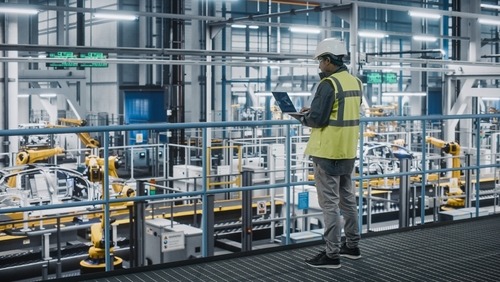Trading Changes in the Economy Using the Purchasing Managers’ Index (PMI)
PMI is calculated using feedback from nationwide purchasing managers, and can provide investors and traders with important insights into the underlying economy—both domestically and internationally

The effects of the COVID-19 pandemic are still being felt around the world, and in many ways, the global economy is still adjusting to a post-pandemic world.
The manufacturing industry, for example, has been under extreme pressure as a result of COVID-related developments in the economy. Imagine, for instance, just how sharply the supply and demand dynamic has shifted in recent years.
At the onset of the pandemic, many manufacturers were forced to shut down their operations as a result of rolling economic lockdowns. In anticipation of a COVID-related recession, many downsized their operations.
But instead of a sharp recession, manufacturers were faced with surging demand. Due to the extensive layoffs conducted in the first half of 2020, they were forced to try and regrow their operations amid an extremely tight labor market.
So where do things stand today? That’s the million dollar question, especially because manufacturing activity is a key leading economic indicator.
Declining manufacturing activity is generally viewed as a red flag for the economy because it provides clear evidence of weakening demand. For this reason, global economists closely track changes in monthly manufacturing activity using the Purchasing Managers’ Index (PMI).
The PMI is a diffusion index that’s calculated using feedback from purchasing managers, and reports whether manufacturing activity is expanding, staying the same, or contracting. PMI is reported as a number between 0 and 100.
A PMI reading above 50 is generally viewed as expansionary compared to the previous month. On the other hand a PMI below 50 is generally viewed as contractionary. When PMI is exactly 50, that’s generally viewed as no change.
PMI can be reported regionally, nationally or internationally. For example, one of the most widely followed gauges of PMI in the U.S. is the Institute for Supply (ISM) Manufacturing Index. This figure is announced on the first business day of every month.
Outside the U.S., there’s an entity known as the International Federation of Purchasing and Supply Management (IFPSM), which provides a global PMI.
Current state of U.S. manufacturing activity
During the first wave of COVID-19 (Q1 2020), manufacturing activity suffered a sharp contraction in the U.S., and PMI plummeted from above 50 in January 2020, all the way down to 41 in April 2020.
However, due to extreme monetary easing by global central banks, manufacturing activity bounced back to historically robust levels rather quickly. By June 2020, PMI in the U.S. was back above 50, and remained there until November 2022.
Manufacturing activity was so strong during that window that PMI in the U.S. climbed above 60 during nine of those 17 months.
However, starting in November 2022, PMI dropped back below 50 for the first time since April 2020. Today, PMI in the U.S. sits at 47.7. That means the U.S. has seen four consecutive months of declining manufacturing activity.
However, the slowdown hasn’t been as severe as what was observed during the onset of the COVID-19 pandemic, as illustrated below.
Unfortunately, U.S. manufacturers also appear to be building up excess inventory.
Excess inventory is typically viewed as negative, because it tends to occur during the latter stages of the business cycle. It can lead to a bottoming in demand, and then sometime later, a fresh economic recovery.
One factor that seemingly contradicts the economic trends is sustained strength in the U.S. labor market. The U.S. economy added over 500,000 new jobs in January, which is robust by any measure. However, most of the recent gains in the labor market appear to be driven by the services sector, not the manufacturing sector.
In the latest jobs report, the two business sectors marking the largest gains were leisure and hospitality. As a result, some labor experts have argued that the overall labor market remains robust because the services sector is playing catch-up in the wake of the pandemic.
Furthermore, some labor experts have also argued that the lack of available workers is forcing the corporate sector to hold onto their employees for a longer period of time, even in the face of weakening demand.
Global manufacturing activity has also slumped
Data from other parts of the world provides further evidence that overall manufacturing activity is slowing.
For instance, the J.P. Morgan Global Composite PMI—which is produced in conjunction with the S&P 500 Global, the ISM and the IFPSM—has consistently printed sub-50 PMI readings since July 2022.
The one exception has been China, but many associate the recent bump in Chinese manufacturing activity to the country’s reopening at the end of 2022.
China’s National Bureau of Statistics reported on March 1 that the country’s overall PMI figure rose to 52.6 in February—the highest reading in the metric since 2012, as illustrated below.
Unfortunately, the data coming out of other countries with heavy exposure to manufacturing has mirrored the trends observed in the U.S., as opposed to the more optimistic data coming out of China.
For example, Japan’s PMI dropped to 47.7 in February 2023, which represented a 2.5-year low for the country.
Manufacturing activity in the Eurozone has also been sluggish. The S&P 500 Global Eurozone Manufacturing PMI index dropped from 48.8 in January to 48.5 in February. That’s eight straight months of sub-50 PMI readings in the European region.
For reference, the world’s largest manufacturers, in order, include China, the U.S., Japan and Germany. Considering China’s heavy influence in global manufacturing, it’s possible that a reopening boom could provide some lift to other key regions in the global economy.
However, until the data reflects a reversal in the current trend, one has to assume that the majority of the world’s manufacturers are currently preparing for leaner times—at least in H1 2023.
Investors and traders may want to monitor both U.S. and global PMI closely in the coming months, because any potential turnaround in the underlying economy would undoubtedly be reflected in this metric.
To track and trade ongoing developments in the U.S. manufacturing sector, readers can also add the following exchange-traded funds (ETFs) to their watchlists:
- First Trust RBA American Industrial Renaissance ETF (AIRR)
- Industrial Select Sector SPDR Fund (XLI)
- Invesco DWA Industrials Momentum ETF (PRN)
- Invesco S&P 500 Equal Weight Industrials ETF (RGI)
- iShares U.S. Industrials ETF (IYJ)
- iShares Global Industrials ETF (EXI)
- Vanguard Industrials Index Fund (VIS)
To follow everything moving the markets—including global manufacturing activity—monitor tastylive—weekdays from 7 a.m. to 4 p.m. CDT.
Sage Anderson is a pseudonym. He’s an experienced trader of equity derivatives and has managed volatility-based portfolios as a former prop trading firm employee. He’s not an employee of Luckbox, tastylive or any affiliated companies. Readers can direct questions about this blog or other trading-related subjects, to support@luckboxmagazine.com.



















